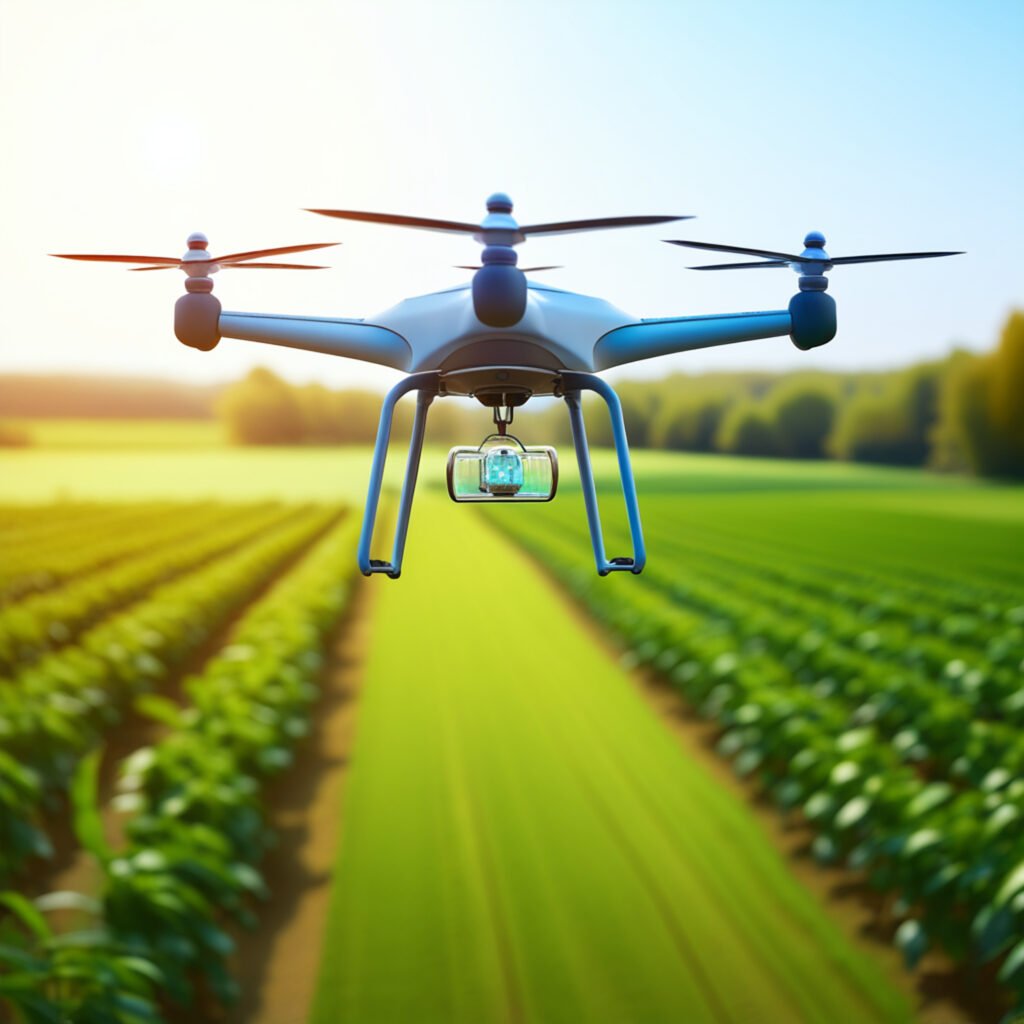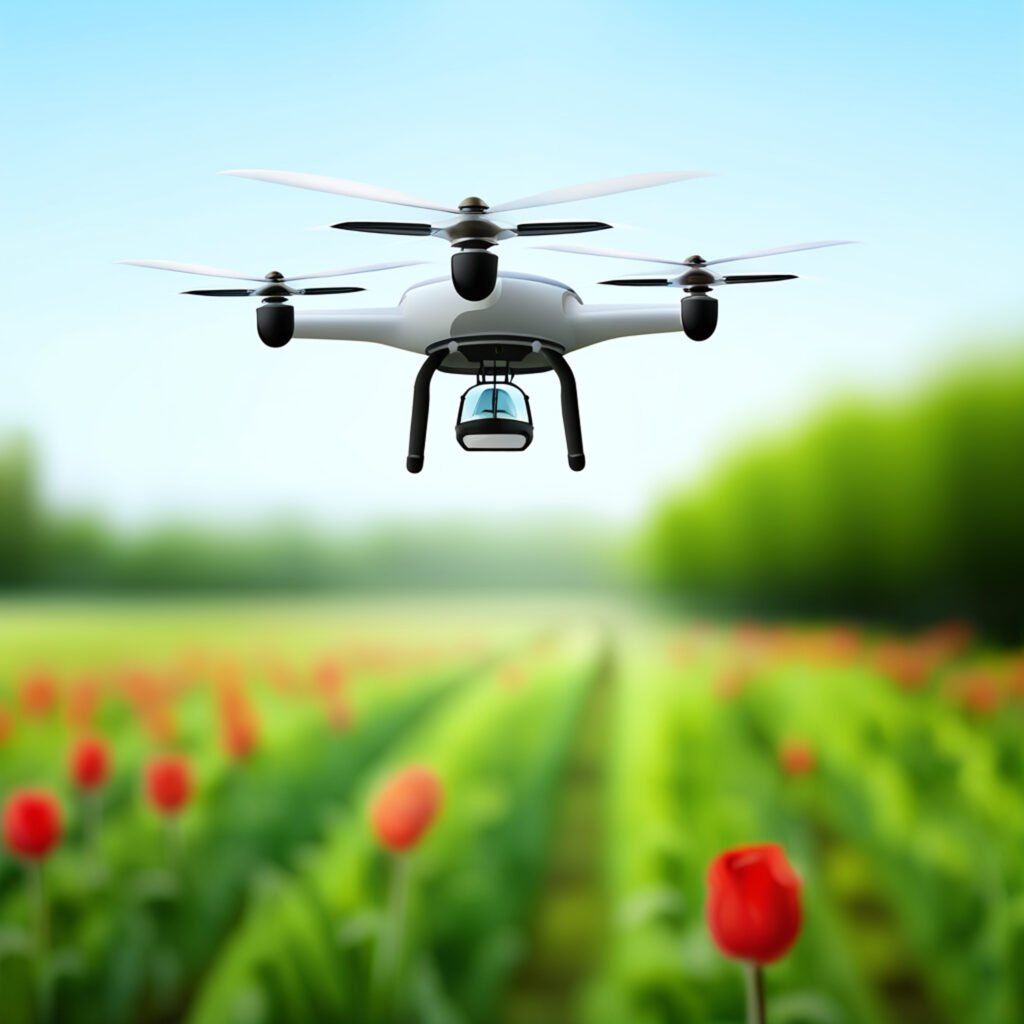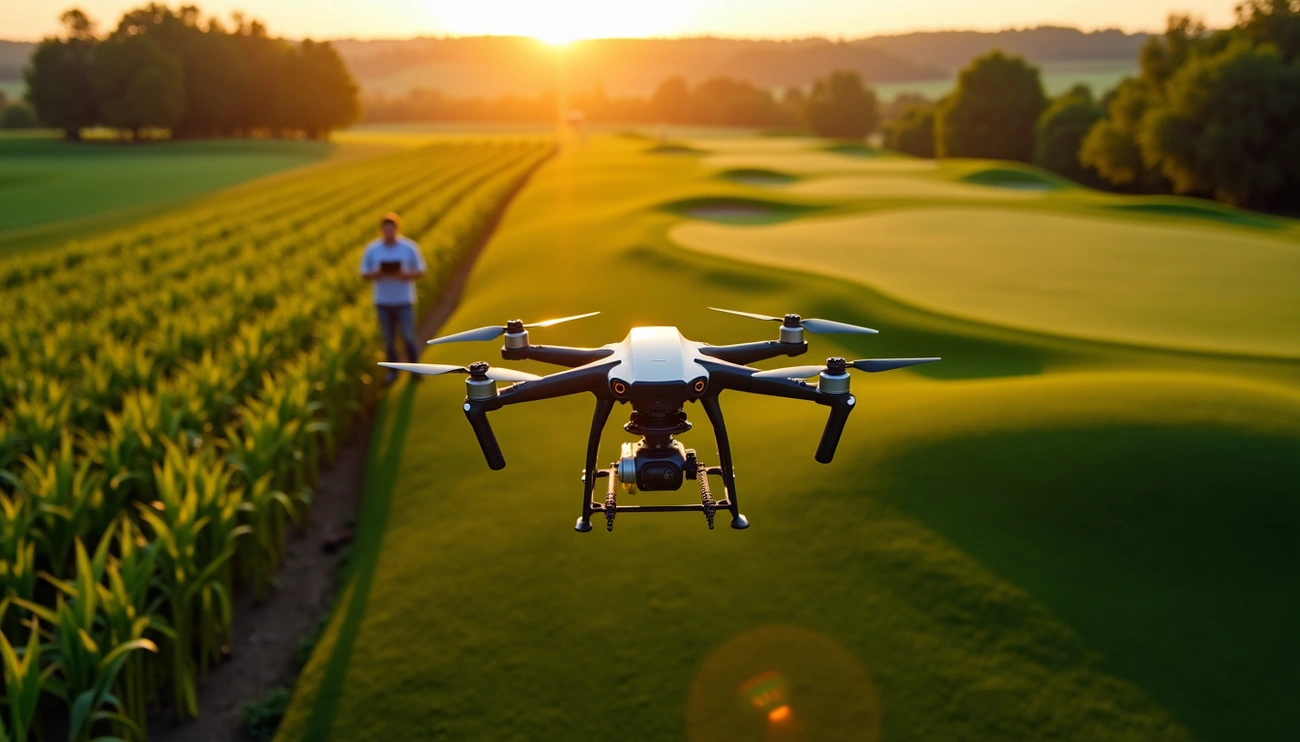Drones are changing modern farming and bringing both advantages and disadvantages to agriculture. Our team has seen these aerial devices make a huge difference, especially those with multispectral imaging technology that spot crop stress early. This tech advancement has changed farmers’ and turf managers’ daily operations.
Taking a look at agricultural drone spraying shows clear benefits. Drones with thermal sensors give detailed views of field irrigation patterns. This helps deliver water exactly where crops need it. Aerial agriculture now includes programmed flight patterns that monitor every inch of farmland. So, drones’ benefits go way beyond convenience to help optimize resources.
This piece will show you how drones are changing everything from large-scale crop management to specialized turf care. You’ll learn about different types of agricultural drones, their real-world uses, and their role in lawn management. It also gets into the environmental and economic effects of this technology. You’ll understand why drones have become vital tools for modern agricultural professionals.
Types of Agricultural Drones and How They Work
Agricultural drones come in different designs. Each design has its own advantages and disadvantages in agriculture that depend on its structure and what it can do. Farmers need to understand these differences to pick the right tool for their needs.
Fixed-wing vs. multi-rotor drones
Fixed-wing drones look like regular airplanes with rigid wings that create lift as they move forward. These drones are great at covering big areas quickly. They can fly 60-90 minutes on one charge. Their streamlined design helps them handle wind better than other drones. Yet they need open areas to take off and land, and can’t stay still in the air.
Multi-rotor drones (usually quadcopters with four rotors) are more agile and can hover in place. They take off and land straight up and down in small spaces, which makes them perfect for close-up inspections. Their flight time is shorter—usually 15-40 minutes—but they can carry heavier loads and are simpler to fly. Multi-rotors work best for precise jobs like targeted spraying or checking specific problem spots.
Hybrid drones mix both designs. They can take off and land vertically while flying as long as fixed-wing models. These drones can stay in the air for 90-180 minutes, which makes them excellent for big operations on tough terrain.
Common sensors used in agricultural drones
The sensors make agricultural drones valuable. RGB cameras take true-color pictures like human eyes see, which helps with simple field checking and map creation.
Multispectral sensors capture information beyond visible light. They detect near-infrared bands that show plant health problems before you can see them. These sensors create vegetation indices like NDVI (Normalized Difference Vegetation Index) that relate to biomass and crop health.
Thermal sensors find temperature differences across fields. They help spot irrigation problems by showing areas where plants need water. LiDAR (Light Detection and Ranging) sensors use laser pulses to build precise 3D models of the land. These models help analyze drainage patterns and land shape.
How drones collect and process data
Special software helps plan drone flights. Pilots set the area to cover, height, speed, and image overlap—usually 70-80% between pictures.
Drones take pictures and sensor readings in a pattern while keeping track of GPS locations for each data point. A 60-90-acre field might need 300 separate photos to create a detailed map.
After flying, software stitches these images together to create orthomosaic maps—detailed views of entire fields from above. These maps help generate applicable information about crop health, soil conditions, and resource needs. Farmers use this processed data to make smart choices about watering, fertilizing, and pest control.
Key Applications in Crop Management
Modern farming now depends on drones to manage crops with precision. These flying tools solve many crop-related problems in unique ways.
Early disease detection using multispectral imaging
Drones equipped with advanced multispectral sensors can spot plant diseases before human eyes can see them. Research shows drone scouting is 96% accurate in finding plant diseases [link_1], while human scouts get it right only 70% of the time. Farmers can treat problems early because they spot them before diseases spread through their fields. The specialized sensors detect small changes in plant health and find everything from fungal infections to viral diseases by looking at light patterns that show stressed or unhealthy plants.
Monitoring irrigation with thermal sensors
Thermal imaging stands out as one of the best benefits of drones in agriculture, especially for managing water. Drones with thermal sensors check plant canopy temperature to figure out the Crop Water Stress Index (CWSI), which gives vital data about plant water needs. This quick and non-invasive method helps farmers see which areas get too much or too little water. They can water crops based on what plants need rather than following a calendar, which saves water by a lot.
Yield prediction and plant health analysis
Machine learning combined with drone data has changed how we predict crop yields. The multispectral images help create plant health indicators that show how well crops will grow. These flying systems collect data about leaf coverage, plant mass, and chlorophyll levels—key signs that tell us how much we’ll harvest. Scientists found that mixing different plant health measurements gives much more accurate predictions.
Targeted aerial spraying for pest control
Agriculture drone spraying works better than old-school methods. Drones find exactly where pests are causing trouble and spray only those spots. This smart approach cuts down on chemicals since farmers don’t need to spray entire fields. The environmental impact goes down while farmers save money. Drones can treat problems quickly—sometimes handling individual trees in minutes—which helps a lot when pest problems need fast action.
Turf and Lawn Care with Drones

Drone technology has revolutionized more than just traditional farming – it’s transforming turf management in amazing ways.
Precision turf management for golf courses
Drones with high-resolution multispectral imaging work like an “MRI for turf.” They spot diseases, pest problems, and nutrient issues before you can see them with the naked eye. Golf course managers review their courses hole-by-hole in quick 15-20 minute daily sessions using drone images. This helps them use their resources better and fix problems fast. The technology lets managers stay ahead of issues instead of just reacting to them, which keeps the courses looking great and playing well.
Uniform fertilization and aeration
Drones help turf managers achieve uniform application of treatments. Every patch of grass gets the right amount of care without waste. Aerial spraying delivers fertilizers exactly where needed, which cuts down on runoff and helps the environment. Drones spread treatments more evenly across the whole area, unlike old methods that often left some spots with too much or too little.
Monitoring sports fields for wear and tear
Sports fields also get huge benefits from drone monitoring that spots trouble areas with amazing accuracy. Drones can fly the same path each day on autopilot. They take aerial and thermal pictures that create detailed digital maps. Maintenance teams use these maps to see where the field gets the most wear and fix high-traffic areas before they get damaged.
Reducing chemical use in lawn care
The benefits of drones in agriculture ended up creating big environmental wins through targeted spraying. Using treatments only where needed has cut down chemical use. This precise approach means less runoff into water sources and healthier turf. Some places report their water usage decreased by up to 25%, and they’ve cut pesticide and fertilizer use by about 15%.
Benefits and Future of Agricultural Drones

Agricultural drones continue to demonstrate their worth in farming operations worldwide. Farmers see measurable benefits ranging from environmental protection to economic advantages.
Environmental benefits of drone spraying
Drone technology brings remarkable ecological improvements to farming. Agricultural drones saved 222 million tons of water by the end of 2024. Chemical product usage dropped by 47,000 metric tons. These reductions led to decreased carbon emissions of 30.87 tons, which equals the annual carbon absorption of 1.2 billion trees. Targeted treatments through precision application minimize chemical runoff into nearby ecosystems.
Cost and labor savings for farmers
Drone adoption offers substantial financial returns to farmers. DJI Agras T40 and T50 drone users in Brazilian coffee farms cut costs by 70% compared to manual spraying methods. They also saved 50% versus traditional tractor applications. Labor needs dropped by 50-80%. Vineyard spraying time decreased from 3-4 days to just 2.5 hours. Operators can recover their drone investment within 4-6 weeks by charging $15/acre for services.
Integration with AI and smart farming systems
AI capabilities boost drone performance through advanced data analysis, predictive modeling, and live decision-making. Smart systems analyze soil moisture data and weather forecasts to create optimal irrigation schedules. This combination results in more efficient and environmentally responsible farming operations.
Trends in drone adoption and innovation
The global agricultural drone market shows explosive growth, expanding from USD 2.01 billion in 2024 with a projected CAGR of 32.0% through 2029. New developments include swarm technology for coordinating multiple drones, better battery life, and larger payload capacities ranging from a few gallons to almost 30 gallons. Regulatory frameworks and financial incentives like subsidies help drive wider adoption, despite some challenges.
Conclusion
Agricultural drones have turned out to be real game-changers for modern farming and turf management. This piece shows how these flying tools give unmatched benefits to crop operations of all sizes and specialized lawn care. These machines detect plant diseases with 96% accuracy, create detailed field maps, and deliver targeted treatments. This is just the start of what this technology brings to the table.
These benefits go way beyond simple convenience. Farmers who use drones see huge drops in water usage, chemical applications, and labor costs. Golf course managers cut down inspection time from hours to quick 15-minute aerial checks. The green impact stands out too – these drones help reduce carbon emissions equal to what 1.2 billion trees would offset.
Each drone type serves a unique farming need. Fixed-wing models work best to survey big areas quickly, while multi-rotor drones excel at precise applications. These machines carry sensors – from multispectral cameras to thermal imaging systems – that turn raw data into practical insights farmers couldn’t get before.
The agricultural drone market keeps growing faster, and experts predict a 32% growth rate through 2029. New developments like swarm technology, better batteries, and bigger payloads drive this growth. Despite some rules and regulations to navigate, the money saved and environmental perks make more agricultural professionals want to use drones.
Agricultural drones aren’t just another tech trend – they’ve changed how we think about farming and land management. They give detailed, practical data and use fewer resources, which fits perfectly with modern agriculture’s needs. Smart farming practices will rely on drones without doubt as essential tools for success in agriculture.

